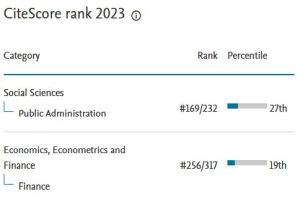Exit plan of financial investors in growing businesses from legal and accounting aspects in Hungary
DOI:
https://doi.org/10.35551/PFQ_2025_1_3Keywords:
exit plan, financial investor, shareholder’s value, G30, K22Abstract
Starting from the doctrinal distinction between the company contract and the syndicate contract, the paper presents, through practical examples, the possibilities of enforcing complex ownership interests derived from the complementary institutional systems of company and contract law. In the case of joint stock companies, company law itself defines a multifaceted set of instruments for the practical regulation of the long-term owner-shareholder cooperation of founders (types of shares, classes of shares), which makes the joint stock company form the most suitable form of company for capital investment in the SME sector (especially for start-up companies). However, beyond the institutional framework of company law, practice has also developed a number of forms of contractual law to effectively model syndicated management (call and put options, drag-along and tag-along rights, etc.), with a focus on the detailed rules of the investment exit event regime. In addition to the legal guarantees to be provided to financial investors, the assets, financial and income situation of the investee company must be measured on an ongoing basis, based on a set of indicators that can be agreed in advance by the parties, in order to determine the optimal exit date. Accounting reports provide the primary information base for this metric system and therefore reliable and fair accounting reports are a key element in this decision and evaluation situation.
References
Babkin, Aleksandr, Nadezhda Kvasha, Daniil Demidenko, Ekaterina Malevska-ia-Malevich, and Evgeny Voroshin. 2022. Risks 11 (1): 3. https://doi.org/10.3390/risks11010003.
Beck, Thorsten Beck, Ross Levine, and Norman Loayza. 2000. Journal of Financial Economics 58 (1-2): 261-300. https://doi.org/10.1016/S0304-405X(00)00072-6.
Benkraiem, Ramzi, Safa Gaaya, Faten Lakhal, and Nadia Lakhal. 2023. “Economic Policy Uncertainty, Investor Protection, and the Value of Excess Cash: A Cro-ss-Country Comparison”. Finance Research Letters 52 (March): 103572. https://doi. org/10.1016/j.frl.2022.103572.
Bennedsen, Morten, and Kasper Meisner Nielsen. 2010. Journal of Banking & Fi-nance 34 (9): 2212-29. https://doi.org/10.1016/j.jbankfin.2010.02.007.
Bennedsen, Morten, Kasper Meisner Nielsen, and Thomas Vester Nielsen. 2012. “Private Contracting and Corporate Governance: Evidence from the Provision of Tag-along Rights in Brazil”. Journal of Corporate Finance 18 (4): 904-18. https://doi.org/10.1016/j.jcorpfin.2011.03.007.
Boursicot, Delphine, Geneviève Gauthier, and Farhad Pourkalbassi. 2019. Risks 7 (2): 47. https://doi.org/10.3390/risks7020047.
DeTienne, Dawn R. 2010. “Entrepreneurial Exit as a Critical Component of the Entrepreneurial Process: Theoretical Development”. Journal of Business Venturing 25 (2): 203-15. https://doi.org/10.1016/j.jbusvent.2008.05.004.
Fu, Tong, Jingsi Leng, Ming-Tsung Lin, and John W. Goodell. 2022. “External Investor Protection and Internal Corporate Governance: Substitutes or Comp-lements for Motivating Foreign Portfolio Investment?” Journal of International Financial Markets, Institutions and Money 81 (November): 101686. https://doi.or-g/10.1016/j.intfin.2022.101686.
Huang, Yuan, Xiao Li, and K.C. John Wei. 2021. “Investor Protection and Resource Allocation: International Evidence”. International Review of Economics & Finance 75 (September): 625-45. https://doi.org/10.1016/j.iref.2021.04.017.
Janku, Martin. 2014. “Statutory Pre-Emption Right as Changed by the New Civil Code”. Procedia Economics and Finance 12: 259-64. https://doi.org/10.1016/S2212-5671(14)00343-8.
Lacave, Ma Isabel Sáez, and Nuria Bermejo Gutierrez. 2010. “Specific Invest-ments, Opportunism and Corporate Contracts: A Theory of Tag-along and Drag-along Clauses”. European Business Organization Law Review 11 (3): 423-58. https://doi.org/10.1017/S1566752910300061.
Pisoni, Alessia, and Alberto Onetti. 2018. “When Startups Exit: Comparing Stra-tegies in Europe and the USA”. Journal of Business Strategy 39 (3): 26-33. https://doi.org/10.1108/JBS-02-2017-0022.
Rappaport, Alfred. 1997. Creating Shareholder Value: A Guide for Managers and In-vestors. ISBN 13: 9780684844107
Szabó, Gergely. 2012. “Texas Shoot-out, or collateral constructions in the syn-dicate bond”. Debrecen Legal Workshop 9 (3): 118-29. https://doi.org/10.24169/DJM/2012/3/12.
Act V of 2013 on the Civil Code (Hungarian Gazette No. 31 of 2013)
Downloads
Published
How to Cite
Issue
Section
License
Copyright (c) 2025 Public Finance Quarterly

This work is licensed under a Creative Commons Attribution 4.0 International License.
Authors assign copyright to Pénzügyi Szemle / Public Finance Quarterly. Authors are responsible for permission to reproduce copyright material from other sources.











